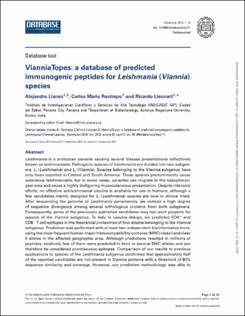| dc.contributor.author | Llanes, Alejandro | |
| dc.contributor.author | Restrepo, Carlos Mario | |
| dc.contributor.author | Lleonart, Ricardo | |
| dc.date.accessioned | 2020-06-13T04:23:05Z | |
| dc.date.available | 2020-06-13T04:23:05Z | |
| dc.date.issued | 2018-09-21 | |
| dc.identifier.other | doi:10.1093/database/bay111 | |
| dc.identifier.uri | http://repositorio-indicasat.org.pa/handle/123456789/57 | |
| dc.description | Leishmania is a protozoan parasite causing several disease presentations collectively known as leishmaniasis. Pathogenic species of Leishmania are divided into two subgenera, L. (Leishmania) and L. (Viannia). Species belonging to the Viannia subgenus have only been reported in Central and South America. These species predominantly cause cutaneous leishmaniasis, but in some cases, parasites can migrate to the nasopharyngeal area and cause a highly disfiguring mucocutaneous presentation. Despite intensive efforts, no effective antileishmanial vaccine is available for use in humans, although a few candidates mainly designed for L. (Leishmania) species are now in clinical trials. After sequencing the genome of Leishmania panamensis, we noticed a high degree of sequence divergence among several orthologous proteins from both subgenera. Consequently, some of the previously published candidates may not work properly for species of the Viannia subgenus. To help in vaccine design, we predicted CD4+ and CD8+ T cell epitopes in the theoretical proteomes of four strains belonging to the Viannia subgenus. Prediction was performed with at least two independent bioinformatics tools, using the most frequent human major histocompatibility complex (MHC) class I and class II alleles in the affected geographic area. Although predictions resulted in millions of peptides, relatively few of them were predicted to bind to several MHC alleles and can therefore be considered promiscuous epitopes. Comparison of our results to previous applications to species of the Leishmania subgenus confirmed that approximately half of the reported candidates are not present in Viannia proteins with a threshold of 80% sequence similarity and coverage. However, our prediction methodology was able to predict 70–100% of the candidates that could be found in Viannia. All the prediction data generated in this study are publicly available in an interactive database called VianniaTopes. | en_US |
| dc.description.abstract | Leishmania is a protozoan parasite causing several disease presentations collectively known as leishmaniasis. Pathogenic species of Leishmania are divided into two subgenera, L. (Leishmania) and L. (Viannia). Species belonging to the Viannia subgenus have only been reported in Central and South America. These species predominantly cause cutaneous leishmaniasis, but in some cases, parasites can migrate to the nasopharyngeal area and cause a highly disfiguring mucocutaneous presentation. Despite intensive efforts, no effective antileishmanial vaccine is available for use in humans, although a few candidates mainly designed for L. (Leishmania) species are now in clinical trials. After sequencing the genome of Leishmania panamensis, we noticed a high degree of sequence divergence among several orthologous proteins from both subgenera. Consequently, some of the previously published candidates may not work properly for species of the Viannia subgenus. To help in vaccine design, we predicted CD4+ and CD8+ T cell epitopes in the theoretical proteomes of four strains belonging to the Viannia subgenus. Prediction was performed with at least two independent bioinformatics tools, using the most frequent human major histocompatibility complex (MHC) class I and class II alleles in the affected geographic area. Although predictions resulted in millions of peptides, relatively few of them were predicted to bind to several MHC alleles and can therefore be considered promiscuous epitopes. Comparison of our results to previous applications to species of the Leishmania subgenus confirmed that approximately half of the reported candidates are not present in Viannia proteins with a threshold of 80% sequence similarity and coverage. However, our prediction methodology was able to predict 70–100% of the candidates that could be found in Viannia. All the prediction data generated in this study are publicly available in an interactive database called VianniaTopes. | en_US |
| dc.format | application/pdf | |
| dc.language.iso | eng | en_US |
| dc.rights | Info:eu-repo/semantics/openAccess | |
| dc.rights | https://creativecommons.org/licenses/by/4.0/ | |
| dc.subject | immunogenic peptides | en_US |
| dc.subject | Leishmania | en_US |
| dc.subject | species | en_US |
| dc.title | VianniaTopes: a database of predicted immunogenic peptides for Leishmania (Viannia) species | en_US |
| dc.type | info:eu-repo/semantics/article | en_US |
| dc.type | Info:eu-repo/semantics/publishedversion | |

